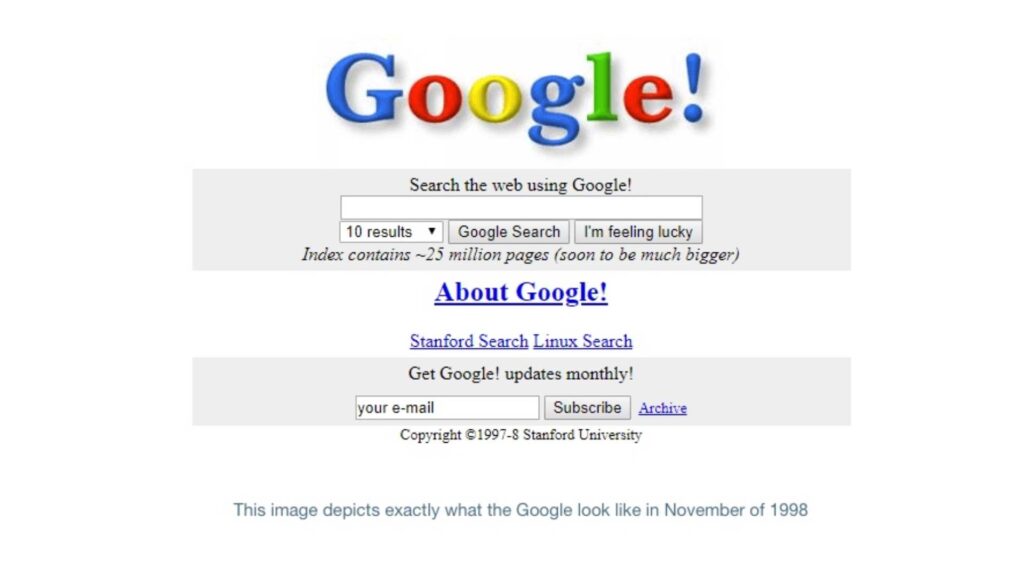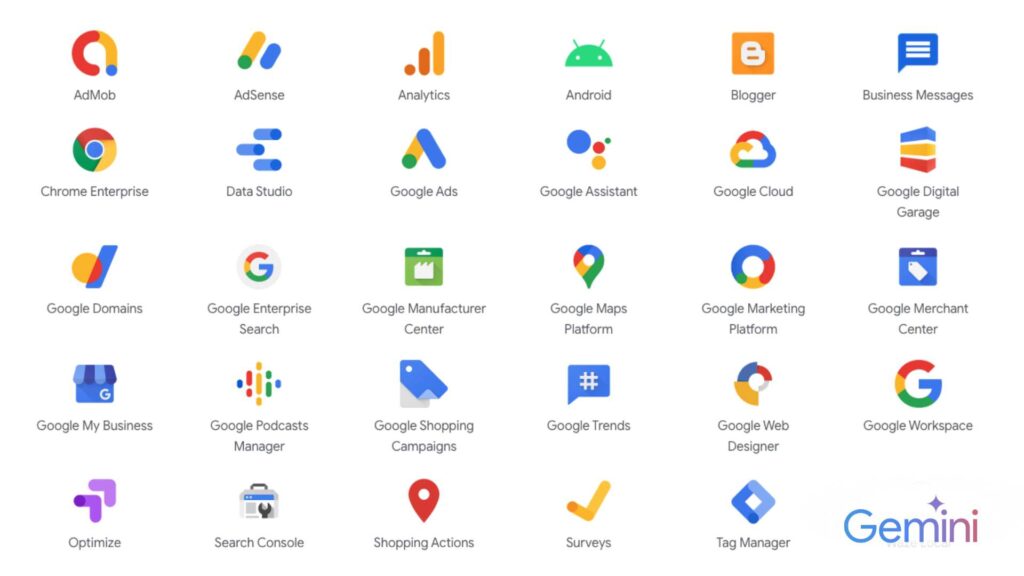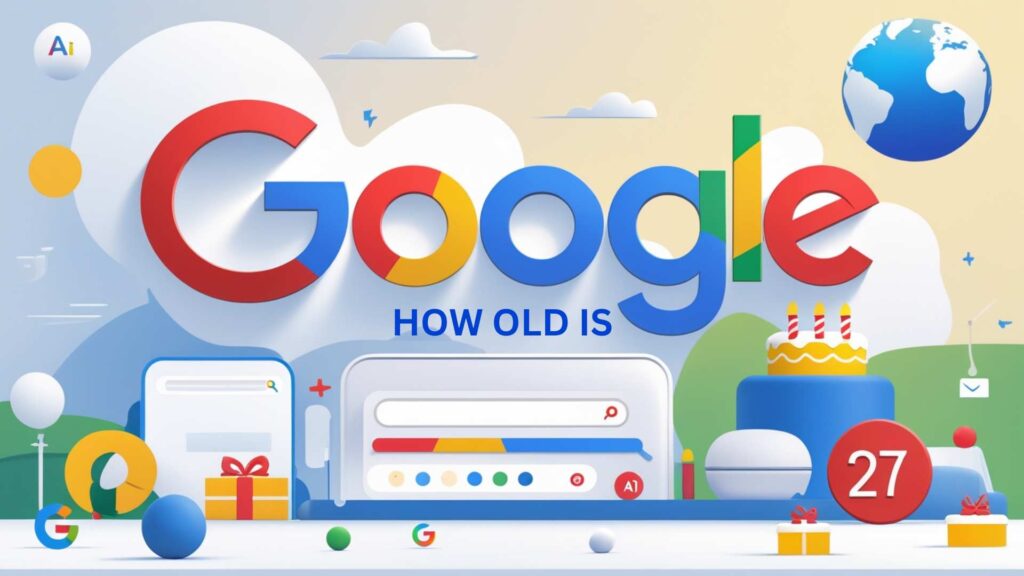Few organisations have impacted the world more in the digital world of 2025 than Google does today. Her role in managing our information discovery activities and running business operations remains substantial throughout 2025. What is Google’s exact age in the year 2025? The straightforward query reveals the amazing historical development extending across 27 years of technology breakthroughs, which reshaped both industries and innovation and technological transformation. Our knowledge of Google’s history enables us to comprehend the transformations that technology has caused in our information age society and the contemporary world. From its start as a straightforward search engine project, Google expanded to become a worldwide company of remarkable value, which changed how people access information and their digital communication methods.
Through an in-depth exploration we will learn How Old Is Google in 2025 along with remarkable facts about its explosive growth and explain how an experimental college project evolved into the global technology giant that paradigm shifts our future.
The Big Reveal: Google’s Age in 2025
The straightforward answer is that in 2025, Google will turn 27 years old.
Think about it: Google is now old enough to have a career, pay bills, and maybe even have a quarter-life crisis!!
Well, Google was officially incorporated on September 4, 1998, making 2025 its 27th year of official existence. However, the true story of Google’s age begins earlier than its incorporation date, with the project’s roots reaching back to 1996 when two Stanford PhD students began exploring a new approach to searching the internet.
To properly understand how old is Google, we need to distinguish between several key milestones:
- 1996: The initial research project begins at Stanford
- 1997: The domain google.com is registered
- September 4, 1998: Google was officially incorporated as a company
- 2004: Google goes public with its IPO
- 2015: Google reorganizes under Alphabet Inc.
Google’s 27-year existence makes it a seasoned technology player in the market, yet still younger than seminal tech businesses such as IBM (founded in 1911) and HP (founded in 1939). The company existed for a notable percentage of the web’s commercial period because Google began operations during the early 1990s, when the commercial internet was just starting to spread throughout the population.
What’s truly remarkable when considering how old is Google is not just its age, but the pace and scale of its growth during this relatively short timespan. From a startup with less than $100,000 in initial funding to a global technology leader with a market capitalization exceeding $1.85 trillion in 2025, Google’s trajectory represents one of the most extraordinary business success stories in history.
From Stanford Dorms to Global Domination: The Humble Beginnings
The Founders’ Story

The creation of the world-renowned technology company Google originates from the partnership between Larry Page and Sergey Brin. Page planned admission to Stanford University during 1995 when Brin was already studying there and assigned to accompany him on a tour. The first encounter between these two talented people resulted in a sharp disagreement as they clashed about their concepts. Their controversial exchange developed into an intellectual framework that eventually evolved into the platform known as Google.
Page studied the mathematical link structures of the internet because he followed computer science since his days as the son of two professors in the field. Brin came into the partnership with his dual expertise in mathematics and computer science, which made him the ideal working partner with Page. Their combined expertise included flawless technical skills, aggressive business development, and comprehensive academic methodology, which allowed them to confront the chaotic nature of early internet systems.
The emergence of Google as a concept began in 1995-1996 when its intellectual bases were first developed. Page believed that information about relevance and website importance remained unused by existing search engines because he focused on understanding how websites connected through backlinks.
The “BackRub” Project
Page and Brin initiated their search engine development under the original name “BackRub” after it gained precision by analyzing backlink relationships among websites. This predecessor project became the origin of Google’s core principles before the company received its famous name. A revolutionary product emerged from BackRub because its PageRank algorithm (named after Larry Page) provided groundbreaking website rankings by assessing content quality and external links from other web pages. The method differed substantially from conventional search engines because it examined site interrelations in addition to word matching.
From his dormitory room, Page developed the initial search engine crawler using basic computers. BackRub launched its web indexation in March 1996 by starting with the Stanford site before it expanded its domain via link traversal. It is remarkable to think about Google’s age and global operation size when analyzing its original small-scale operations from this dormitory room. This humble beginning is startling when considering how old Google is now and its current scale, with data centers worldwide processing billions of searches daily.
Page and Brin conducted their research to tackle the information retrieval problem. The project started its operation at backrub.stanford.edu on Stanford’s servers. It used up half of the university’s total network bandwidth, which indicated both its capacity for growth and substantial resource requirements.
The Birth of “Google”

The company renamed BackRub to Google in 1997 when the project started demonstrating strong growth. The naming process of “Google” emerged from a spelling mistake of “googol,” which represents the mathematical term indicating 1 followed by a hundred zeroes (10^100). Page and Brin chose “Google” as the name that symbolized their effort to arrange an endless amount of web information.The domain google.com was registered on September 15, 1997, marking another important milestone when considering how old is Google as a brand. This name reflected their ambitious vision—to create a system capable of managing and organizing vast amounts of information, a googol’s worth of data.
In 1995, the first version of the Google search engine appeared on the Stanford website, revolutionizing search through its simplicity. Users recognized that Google search results delivered better quality content and more appropriate matches compared to Excite, AltaVista and Yahoo search engines of that time. Google distinguished itself from other portals of that time by presenting its interface in a tidy manner that avoided the confusing structures found on typical web pages. During the final months of 1997 the Google.stanford.edu website received increasing user traffic which demonstrated the technological benefits for academic users. The project exceeded its initial academic scope, which led the creators to recognize the need for an official business framework.
The First Investment
When 1998 started, Page and Brin understood that they needed to establish their company or a licensing agreement with existing businesses. The founders of Google battled in vain to sell their creation to Yahoo without success before launching a new company following encouragement from Stanford professors, together with funding from Silicon Valley investors. In August 1998, Sun Microsystems co-founder Andy Bechtolsheim wrote a $100,000 check to “Google, Inc.” after briefly demonstrating their search engine. There was just one problem—Google Inc. didn’t exist yet as a legal entity. This led to the official incorporation of Google on September 4, 1998, the date most commonly used when calculating how old Google is as a company.
With Bechtolsheim’s investment banked, Page and Brin moved out of their dorms and set up Google’s first office in Susan Wojcicki’s garage in Menlo Park, California. Wojcicki (who would later become CEO of YouTube after Google acquired it) rented the garage to the new company for $1,700 per month. This garage would later become famous as part of Google’s origin story, much like the garages of Hewlett-Packard and Apple in Silicon Valley lore.
By the end of 1998, Google had:
- An index of about 60 million pages
- A mention in PC Magazine as one of the top 100 websites
- A staff of eight employees
- Initial funding of approximately $1 million from various investors
When examining how old Google is compared to the speed of its early development, what stands out is how quickly the company moved from an academic project to a funded startup. In just over two years, Page and Brin had gone from a research concept to leading a company already gaining recognition for its superior search technology.
ALSO READ:
Google maps scraping tools
Google analytics services
Shocking 7 Facts About Google’s Early Growth
The Garage Startup
Google’s initial growth rates remain impressive because the company leapt beyond its household garage establishment in a remarkably short time period. Google spent only a brief five-month period based in Susan Wojcicki’s garage after which the company needed to move into bigger facilities. Six months after incorporation, Google left the garage space to accommodate its growing workforce by establishing a Palo Alto office with eight employees.
Google experienced such rapid expansion in its first few months of operation given that it had only launched minutes ago as an official company. Without a defined revenue strategy the company was able to draw both talented professionals and investors because of its visionary technological achievements. By mid-199,9 Google managed to process 500,000 daily searches even though its products remained unrecognized by most people in the world. Google attracted users whose word-of-mouth promotion spread rapidly because technically skilled internet users recognized how Google provided better search results than its competitors during its first year of operation.
Rapid Indexing
By late 1999, considering how old Google was—barely a year—the company had already indexed more than a billion web pages. This was an astonishing technical achievement at a time when the entire World Wide Web was estimated to contain only a few billion pages. Through its innovative distributed computing approach, Google could grow quickly by avoiding investments in supercomputers. The company created its infrastructure by connecting Linux-powered commodity PCs as a cost-effective method that became the foundation for future Google massive data center architecture.
The most astonishing feature of Google’s early indexing procedures was the incredible performance of its code. The competitors who pursued web indexation required major hardware infrastructure, while Google implemented algorithms that operated with high efficiency to maximize their technical capability. Google’s technological superiority resulted in continuous improvements of search quality, from user growth to algorithm enhancements to next-level search outcomes.
Early Innovations
Few people today appreciate the extent of innovation that Google brought even before it evolved into its present role as an innovation leader. The auction-based advertising system AdWords introduced by Google entered the market in 2000. AdWords revolutionized advertising by connecting advertisements with user interests and thus shifted away from annoying interruptive methods. This inventive approach developed the magnet that sustained Google during its unprecedented growth period for many decades. At the age of two Google launched its search function in 15 different languages during 2000.
- In 2000 Google launched an early globalization move which demonstrated foresight since major internet businesses concentrated their operations on speaking English markets exclusively. Google released its first hardware product as the search appliance in 2002 where businesses could buy it to perform Google search functions on their internal files within a yellow rack-mounted server unit. Few analysts expected such a hardware product launch from Google which had been operating as a web service company only 4 years earlier.
- The organization needed to launch the minimalist homepage design because it was different from the overloaded portal sites popular during that period. Since its founding both Google co-founders Page and Brin had limited HTML skills while making design choices that emphasized functionality rather than visual appeal.
- When Google was newly founded, engineers received permission to pursue personal projects as part of the “20% time” policy. Coupled with minimal supervision, this was how a young company empowered its employees to create some of its flagship products, such as Gmail and Google News.
- The company’s famously sparse homepage—radical at a time when portal sites crammed as much content as possible onto their landing pages—was actually born of necessity. When analyzing how old Google’s iconic minimalist design is, it dates back to the very beginning when Page and Brin had limited HTML skills and focused on functionality over design.
The Exponential Expansion: Google’s Journey to a Tech Giant
Key Product Launches

Google’s transformation from an initial search company to its current role as technology conglomerate followed a progression of important product launches which intensified its market reach.
- 2000 – Launched AdWords, introducing pay-per-click advertising.
- 2000 – Added support for 10 languages, kicking off early globalization efforts.
- 2001 – Introduced Google Image Search, adding visual results to web queries.
- 2003 – Acquired Blogger, marking Google’s first major content platform move.
- 2004 – Launched Gmail on April 1st with 1 GB of free storage—many thought it was an April Fools’ joke.
- 2005 – Launched Google Maps, changing how people navigate the world.
- 2005 – Introduced Google Earth, letting users explore the globe virtually.
- 2006 – Acquired YouTube for $1.65 billion, securing its place in online video.
- 2006 – Launched Google Translate, opening up multilingual access to web content.
- 2007 – Unveiled the Android operating system to the public.
- 2008 – Released Google Chrome, its fast and minimalist web browser.
- 2008 – First Android phone, the T-Mobile G1, was launched.
- 2011 – Launched Chromebooks and the Chrome OS ecosystem.
- 2011 – Introduced Google+, its attempt to take on Facebook in social media.
- 2012 – Launched Google Now, an early AI-driven assistant.
- 2013 – Released the futuristic (but short-lived) Google Glass Explorer Edition.
- 2014 – Acquired Nest, expanding into smart home tech.
- 2015 – Announced Alphabet Inc. as a new parent company, restructuring Google’s core businesses.
- 2016 – Launched Google Assistant, integrating AI into its product ecosystem.
- 2017 – Google Lens launched, letting your camera understand the world.
- 2020 – Google Meet went free for all during the pandemic, rivaling Zoom.
- 2021 – Tensor chip debuted in Pixel 6, Google’s first custom smartphone chip.
- 2022 – Pixel Watch finally arrived, integrating Fitbit with Wear OS.
- 2023 – Bard launched, Google’s answer to ChatGPT in the AI race.
- 2023 – Pixel Fold released, Google’s first foldable phone hits the market.
- 2024 – Gemini AI launched, replacing Bard with a next-gen AI experience.
- 2024 – AI-powered Search Generative Experience (SGE) introduced to revamp search results.
- 2025 – Pixel 9 Series expected, with even deeper Gemini integration.
- 2025 – Gemini Ultra for Workspace launches, supercharging Docs, Sheets, and Gmail.
These product releases served Google as both ways to extend its products while simultaneously entering fresh technological areas. Throughout its operations the company proved expert in developing new products while retaining excellence in acquiring scaled-up promising outside technologies.
Global Reach and Impact
The fast rate at which Google established its worldwide influence during its lifetime stands out when considering its age:
- Google’s search capabilities expanded to 15 languages by the start of 2000. As of 2025, Google Search provides services in more than 150 languages, reaching every nation on the planet. Google’s primary globalization occurred faster than any previous business endeavor it compares to.
- Google’s data centers serving the company’s services grew from one facility to a worldwide chain extending across five continents. Since its first global data center network launch in 1995 Google has grown its computing system into one of the world’s largest throughout twenty years of expansion.
- Google’s advertising platform has generated a transformational economic effect on business operations. The combination of AdWords (later known as Google Ads) and AdSense established complete new methods that generated income for multiple businesses and content creators operating worldwide. The 25-year-old Google advertising platform has allowed trillions of dollars in economic activity to occur because of its age until 2025.
- Google controls technological development while dominating every major aspect of modern daily life, including education, healthcare, transportation, and all other major sectors. Through its platform, Google Classroom delivers educational changes to millions of students across the world. Due to Waze and Google Maps, people’s navigation methods shift. Through Google Scholar, users gain easier access to academic research.
- Global expansion for Google brought multiple difficulties to the company. Google’s entry into China resulted in major regulatory and moral complications causing the company to pull out of the market in 2010. Google faced major regulatory problems throughout Europe that led to the company paying billions of dollars in antitrust fines.
Evolution of the Search Algorithm
The foundational search engine mechanism at Google has been through ceaseless development since their establishment here as follows:
- The pioneering PageRank algorithm from the past has gained hundreds of extra ranking factors which developed after its initial introduction. A complete transformation exists between Google’s search algorithm from its initial launch in 1998 to its state in the present day because the current version no longer resembles the original framework.
- The search engine has advanced its result-delivering abilities through major algorithm updates that the company calls Panda Penguin and BERT among others. The major updates in Google’s service draw from the company’s commitment to solve growing problems in information search and retrieval.
- Google introduced RankBrain during 2015 which became the initial search implementation of machine learning technology. The introduction of this development represented a vital advancement for search because it shifted from being controlled by human programming to self-learning automatic algorithms.
- AI implementation has experienced rapid growth in recent years. Google’s AI-powered search capabilities are over ten years old, having begun developing thirty-five months ago to completely reshape the methods used to process and retrieve information.
- Google Search started with basic text searching techniques but became capable of interpreting user goals and handling conversational inquiries and recognizing requirements before people voice them. The evolution signifies both technological progress and improved knowledge about human patterns of information retrieval.
Transition to Alphabet
In 2015 Google achieved one of its most important milestones by establishing Alphabet Inc as its parent company. The company separated its foundational internet businesses from its innovative experimental projects through this reorganization. Under Google LLC, the core business of Search and Ads, along with Android users, YouTube viewers, and Maps directory users, received continuous support, while separate Alphabet companies supported research at Waymo and Verily and pursued experimental initiatives. At 17 years old, Google demonstrated its wide range of business interests through its restructuring. Google, as a subsidiary of Alphabet, has maintained its position for ten years, so both its core business operations and other Alphabet subsidiaries can follow their independent directions.
Under the Alphabet transition, Larry Page became the CEO of Alphabet and Sergey Brin became its president, but Sundar Pichai took over as Google’s CEO. Both Page and Brin relinquished their executive responsibilities in 2019, and Pichai became the CEO of Google while assuming the same position at Alphabet. The company successfully evolved into a diversified technology conglomerate through its corporate transformation, which moved the business from its original single-product startup.
Google in 2025: What the Future Holds
AI and Machine Learning
By 2025, when analyzing how old is Google’s serious investment in artificial intelligence, the company has been at the forefront of AI research for well over a decade. Google’s acquisition of DeepMind in 2014 signaled its commitment to advanced AI, and subsequent developments have positioned the company as a leader in this transformative technology.
Google’s AI initiatives in 2025 include:
- AI Dreamer: According to the Britannica document, this system develops its capabilities over time to master complex operations similar to those found in Minecraft. Due to this achievement, reinforcement learning progressed through a major development milestone.
- Advanced language models: Since BERT and LaMDA, Google has expanded its work into building progressively advanced systems that understand natural language.
- Practical AI applications: Google AI’s technological capabilities now assist in solving difficult issues, ranging from medical diagnosis to climate modeling.
- Ethical AI frameworks: Google has established complete systems for conducting responsible AI development to address escalating social concerns about AI impacts.
Google introduced AI throughout its product range to offer users customized interactions based on extensive knowledge retrieval with an intuitive presentation. Throughout approximately eighteen years Google has continuously utilized these concepts as foundational elements for its AI-powered computing vision.
Emerging Technologies
Google dedicates its resources to studying and developing multiple emerging technologies with AI alongside them during the year 2025.
- Quantum computing: Google has strengthened its quantum supremacy announcement from 2019 by developing quantum computing technology, which aims to achieve real-world applications of this disruptive computational approach.
- Augmented reality: The company made progress after Google Glass by creating advanced AR technology platforms that combine with mapping features and information databases.
- Sustainable computing: Google makes strategic investments in carbon-neutral operations that result in new approaches for efficient computing while designing greener data centers.
- Biotechnology: Google uses its data analysis capabilities through Alphabet companies Verily and Calico to address healthcare challenges that include research on aging.
The search engine that began with Google has evolved into new areas of business development that extend beyond its core function. In comparison to its age and expansive technological interests, Google has successfully introduced itself to numerous separate domains during its compressed years of operation.
Ongoing Impact on Society
The third decade of operation for Google has expanded its presence in society far outside its foundation of technology development:
- Information access: Through its goal to scientifically classify all global knowledge Google produced significant changes in human interaction with knowledge.
- Digital privacy: The company’s user data policies and practices have become essential topics for worldwide privacy discussions in the digital landscape.
- Work culture: Google’s business methods regarding workplace design and organizational structure, as well as employee benefits, benefit organizations across the globe.
- Internet regulation: Google’s size powerfully positions it to effect changes in digital policy and internet governance politics.
- Educational access: The educational Chromebooks combined with Google Classroom programs allow the company to influence global educational systems significantly.
Google’s impact on societal issues has been continuous since 1998, with its influence becoming stronger as it extends its business reach.
Conclusion
In examining the question “How old is Google in 2025?”, we’ve uncovered not just a chronological age of 27 years, but a remarkable journey of transformation. Google reached its 27th birthday in 2025 thereby marking both its chronological age and the remarkable path of technological advancement that has affected the entire world. The expression of Google as a leading technology giant represents a direct pattern of the digital world’s fast-moving development between its creation at Stanford University as a research project and its current position today. During its three decades of existence Google succeeded in matching what traditional corporations needed a century to accomplish by transforming from a garage business to become a worldwide enterprise that executes billions of search queries per day as it ventures into AI development alongside healthcare and quantum computing and transportation technologies.
The extraordinary development shows how well Google performs while demonstrating what modern technology can really achieve. The business expansion by Google comes with difficult problems regarding privacy protection and competition and ethical governance which may shape its destiny more than past breakthroughs did. After 27 years Google stands out through its combination of sustained existence alongside its advanced technological paradigm which originates from a culture built on creative problem-solving and constant development.
FAQs
How old is Google in 2025 and when did the company begin operations?
Google was officially incorporated on September 4, 1998, so the company will celebrate 27 years in business in 2025. Larry Page and Sergey Brin established their search engine BackRub in 1996 at Stanford University before Google was officially founded in 1998.
What influence led the creators to name their search engine Google and what is the age of the popular Google brand?
The creators selected “Google” as a derivative from “googol” to indicate 1 followed by 100 zeros. Google acquired its name from its creators, who wanted to direct their mission toward organizing World Wide Web content.
How many years older is Google than major technology organizations in 2025?
Google approaches its 27th year of operation in 2025 while remaining younger than Microsoft (founded in 1975) which is 50 years old and Apple (founded in 1976) that is 49 years old and Amazon (founded in 1994) that is 31 years old. The company established in 2004 surpasses both Facebook/Meta (aged 21 years) and Twitter/X (19 years old) as well as Instagram (founded 15 years ago).
What year did Google become publicly traded, and what financial transformations has it achieved during the subsequent time period?
Google reached its sixth anniversary before going public on August 19, 2004 under a market capitalization of around $23 billion. The market value of Alphabet Inc. reached $1.85 trillion twenty-one years following its public listing as Google, surpassing an impressive 8000% growth.
What is the current age of Alphabet, the parent company under which Google operates, and why did it come into existence?
Alphabet Inc. launched its operations in 2015 becoming a parent company for Google and additional businesses formerly connected to Google. In 2025, Alphabet is 10 years old.

